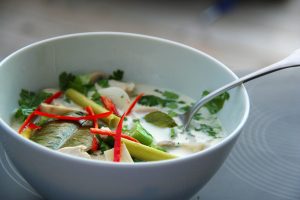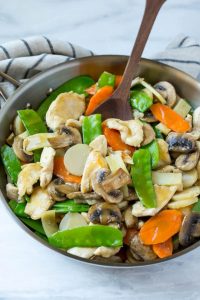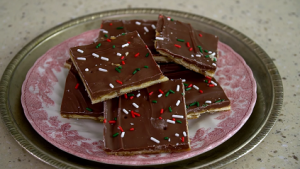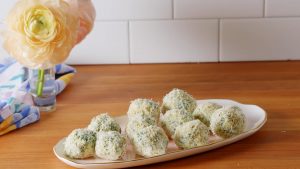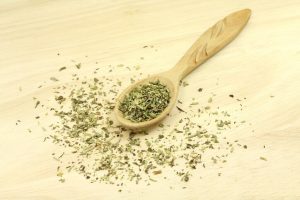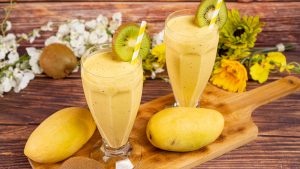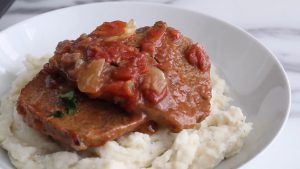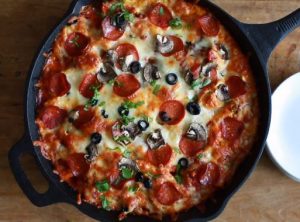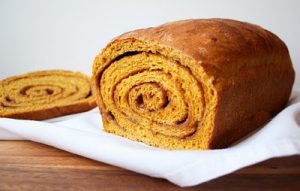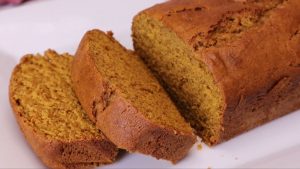The Prawn Paste Chicken, also known as Har Cheong Gai is a flavorful and pleasing dish that originates from Singapore. It's a delightful blend of chicken wings, shrimp sauce, and a variety of seasonings that are harmoniously combined to create a unique, savory treat. If you're adventurous with your palate and love trying out Asian delicacies, this dish will certainly not disappoint you.
The two key ingredients to take note of in this recipe are shrimp sauce and potato starch. Shrimp sauce, also known as prawn paste, is a common ingredient in Asian cooking. It has a pungent aroma and salty taste that gives a unique flavor to the dish. You can find it in Asian grocery stores or in the international aisle of a well-stocked supermarket. Potato starch, used in the batter, is a gluten-free alternative to traditional wheat-based starches. It gives a distinctive crispy texture to the chicken wings when fried.
Ingredients for Prawn Paste Chicken (Har Cheong Gai)
Chicken mid wings: These are the middle section of the chicken wing, smaller but meatier than the drumettes or wing tips.
Shrimp sauce: This is a fermented condiment made from shrimp that gives the dish its unique flavor.
Oyster sauce: A thick, brown sauce with a sweet-salty flavor, used in many Asian dishes.
Sugar: Used to balance the savory flavors in the dish.
Sesame oil: This oil has a strong nutty flavor and is used mainly for its fragrance.
Chinese wine: This is a rice wine used in Chinese cooking, it has a subtle sweetness that enhances the flavor of the dish.
White pepper: A slightly hotter version of black pepper, it gives a gentle heat to the dish.
Salt: Used to enhance the other flavors in the dish.
Plain flour: This is used as the base of the batter to coat the chicken wings.
Potato starch: This is used in the batter to give a crispy texture to the chicken when fried.
Baking soda: Used to give the batter a light, fluffy texture.
Baking powder: This works with the baking soda to lighten the batter.
Eggs: They bind the batter ingredients together.
Water: Used to mix the batter ingredients into a smooth consistency.
Cooking oil: This is used for deep-frying the chicken wings.
Lime wedge: Served with the chicken to add a refreshing citrus flavor.
One reader, Adele Reardon says:





This prawn paste chicken recipe is a game-changer! The flavors are rich and savory, and the crispy coating is absolutely addictive. It's a must-try for anyone who loves bold, delicious dishes. I can't wait to make it again!
Techniques Required
Marinating the chicken wings: In a large mixing bowl, combine the chicken wings, shrimp sauce, oyster sauce, sugar, sesame oil, Chinese wine, white pepper, and salt. Stir to ensure each wing is evenly coated, then cover and refrigerate for up to 2 days.
Making the batter: In a large mixing bowl, combine the plain flour, potato starch, baking soda, baking powder, eggs, and water. Whisk until fully combined, creating a runny yet thick batter that can coat the chicken wings.
Frying the wings: Heat the cooking oil in a wok over medium heat. Dip the marinated wings in the batter and place them in the hot oil in batches of 4. Fry for 3 to 4 minutes until the coating crisps up and turns golden brown. Repeat the frying process until all wings are cooked.
Serving: Plate the wings and serve with a squeeze of lime juice.
How To Make Prawn Paste Chicken (Har Cheong Gai)
These savory Singaporean har cheong gai is coated in a tasteful prawn paste to give you a crispy chicken meal! Serve these up at your next game day party.
Serves:
Ingredients
- 12chicken mid wings
- 2tbspshrimp sauce
- 1tbspoyster sauce
- 2tbspsugar
- 1tsbpsesame oil
- 3tbspChinese wine
- 1tspwhite pepper
- 1tspsalt
For Batter:
- 1cupplain flour
- 1cuppotato starch
- ½tspbaking soda
- ¼tspbaking powder
- 2eggs
- 1cupwater
For Frying:
- 4cupscooking oil
For Serving:
- lime wedge
Instructions
-
In a large mixing bowl, add the chicken wings, shrimp sauce, oyster sauce, sugar, sesame oil, Chinese wine, white pepper and salt.
-
Stir to combine, ensuring each wing is coated evenly.
-
Cover in cling film, then allow to rest in the fridge for up to 2 days.
-
In another large mixing bowl, combine the plain flour, potato starch, bicarbonate of soda, baking powder, eggs and water.
-
Whisk until fully combined. The mixture should be runny but thick enough to hold on the surface of a spoon.
-
Add the oil to a wok over medium heat, then bring up to temperature.
-
Remove the marinated wings from the fridge, then dip them in the batter.
-
Place the battered wings in the oil in batches of 4.
-
Cook for 3 to 4 minutes until the coating crisps up and turns a golden brown.
-
Repeat the frying process until all wings are cooked.
-
Plate up and serve with a squeeze of lime juice.
-
Serve, and enjoy!
Nutrition
- Calories: 9977.92kcal
- Fat: 762.65g
- Saturated Fat: 171.96g
- Trans Fat: 4.36g
- Monounsaturated Fat: 363.42g
- Polyunsaturated Fat: 178.23g
- Carbohydrates: 61.62g
- Fiber: 1.54g
- Sugar: 6.63g
- Protein: 676.63g
- Cholesterol: 2790.06mg
- Sodium: 3476.39mg
- Calcium: 449.71mg
- Potassium: 6894.12mg
- Iron: 33.61mg
- Vitamin A: 1510.57µg
- Vitamin C: 60.33mg
Key Technique for Perfecting Prawn Paste Chicken
To ensure your prawn paste chicken is flavorful and tender, marinate the chicken wings for at least a few hours, but ideally up to 2 days. The longer the wings marinate, the more they absorb the flavors of the shrimp sauce, oyster sauce, and other seasonings. Also, when frying, make sure the oil is hot enough before adding the wings. This will ensure a crispy, golden brown coating. If the oil is not hot enough, the batter may absorb too much oil and become soggy.
Time-Saving Tips for Preparing Har Cheong Gai
Marinate in advance: Marinate the chicken wings in the prawn paste mixture a day or two before cooking to allow the flavors to fully infuse into the meat.
Double up: Make a larger batch of the prawn paste mixture and freeze half of it for future use, saving time on marinating next time.
Prep the batter: Mix the dry ingredients for the batter in advance and store it in an airtight container. When ready to use, just add the wet ingredients and you're good to go.
Use a deep fryer: Consider using a deep fryer instead of a wok for more consistent and efficient frying.
Organize your workspace: Set up a dredging station with the marinated chicken, batter, and a tray for the coated wings to streamline the frying process.
Batch frying: Fry the chicken wings in batches to ensure they cook evenly and to avoid overcrowding the pan.
Invest in a thermometer: Use a kitchen thermometer to monitor the oil temperature accurately for perfectly fried chicken wings.
Delegate: Enlist the help of a friend or family member to assist with the battering and frying process for a quicker cooking experience.
Clean as you go: Wash and clean utensils and equipment while the chicken wings are marinating or frying to minimize post-cooking cleanup time.
Substitute Ingredients For Prawn Paste Chicken (Har Cheong Gai) Recipe
prawn paste - Substitute with fermented shrimp paste: Fermented shrimp paste has a similar umami-rich and savory flavor that can replace the prawn paste in the recipe.
chicken mid wings - Substitute with chicken drumettes: Chicken drumettes are a suitable substitute as they are small, meaty, and perfect for absorbing the flavors of the marinade.
shrimp sauce - Substitute with fish sauce: Fish sauce provides a similar depth of flavor and saltiness that complements the dish well.
oyster sauce - Substitute with hoisin sauce: Hoisin sauce offers a sweet and savory flavor profile that can replace the oyster sauce in the recipe.
sesame oil - Substitute with peanut oil: Peanut oil has a mild nutty flavor that can add a similar depth to the dish as sesame oil.
chinese wine - Substitute with dry sherry: Dry sherry can be used as a substitute for Chinese wine to provide a similar depth of flavor to the dish.
white pepper - Substitute with black pepper: Black pepper can be used as a substitute for white pepper to add a similar level of heat and flavor to the dish.
plain flour - Substitute with all-purpose flour: All-purpose flour can be used as a substitute for plain flour with minimal impact on the recipe.
potato starch - Substitute with cornstarch: Cornstarch can be used as a substitute for potato starch to achieve a similar crispy texture when frying.
baking soda - Substitute with baking powder: Baking powder can be used as a substitute for baking soda to help the batter rise and achieve a light, crispy texture.
eggs - Substitute with flax eggs: Flax eggs can be used as a vegan substitute for eggs to bind the batter and provide a similar texture.
cooking oil - Substitute with vegetable oil: Vegetable oil can be used as a substitute for cooking oil with minimal impact on the recipe.
lime wedge - Substitute with lemon wedge: Lemon wedge can be used as a substitute for lime wedge to provide a similar citrusy flavor to the dish.
Presenting Prawn Paste Chicken in Style
Elevate the plating: When presenting the prawn paste chicken, focus on creating an elegant and visually appealing presentation. Use clean lines and minimalistic plating to showcase the golden brown chicken wings and allow the dish to speak for itself.
Incorporate contrasting colors: Introduce vibrant elements such as a garnish of fresh herbs or microgreens to add a pop of color to the plate. This will create a visually striking contrast against the crispy exterior of the chicken wings, enhancing the overall presentation.
Utilize negative space: Embrace the concept of negative space on the plate to draw attention to the star of the dish – the succulent prawn paste chicken. By allowing the dish to stand out against a clean, uncluttered backdrop, the focus remains on the flavors and textures of the dish.
Implement geometric shapes: Introduce geometric elements in the plating to add a modern and artistic touch. Consider using square or rectangular plates to create clean lines and structured arrangements, enhancing the visual appeal of the dish.
Incorporate edible flowers: Introduce delicate and edible flowers as a sophisticated garnish to add a touch of elegance to the presentation. Choose flowers that complement the flavors of the dish and add a subtle floral aroma to the overall dining experience.
Highlight with sauce drizzles: Use a fine drizzle of the prawn paste sauce or a complementary sauce to add artistic flair to the plate. The strategic placement of sauce not only enhances the visual appeal but also provides an additional layer of flavor to the dish.
Emphasize texture: Incorporate elements with varying textures, such as crispy chicken wings, alongside a side of refreshing pickled vegetables or a light, crunchy slaw. This contrast in textures adds depth to the presentation and elevates the overall dining experience.
Consider the plate shape: Select a plate shape that complements the aesthetic of the dish. Whether it's a classic round plate or a unique, asymmetrical design, the plate shape can enhance the overall visual impact of the prawn paste chicken presentation.
Essential Tools for Making Har Cheong Gai
- Large mixing bowl: A large bowl used for combining and mixing ingredients.
- Wok: A versatile round-bottomed cooking vessel used for stir-frying, steaming, and deep-frying.
- Whisk: A kitchen utensil used for blending ingredients together and incorporating air into the mixture.
- Cling film: A thin plastic wrap used to cover and protect food items.
- Cooking oil: A liquid fat used for frying, sautéing, and other cooking methods.
- Spatula: A flat, flexible utensil used for flipping, spreading, and lifting foods during cooking.
- Knife: A sharp tool used for cutting and preparing ingredients.
- Lime wedge: A small, triangular piece of lime used as a garnish or for squeezing juice over the dish.
Storing and Freezing Har Cheong Gai
Allow the prawn paste chicken to cool completely before storing or freezing. This will prevent condensation from forming and affecting the texture of the crispy coating.
To store in the refrigerator, place the cooled har cheong gai in an airtight container lined with paper towels. The paper towels will absorb any excess moisture, helping to maintain the crispiness of the chicken. Store in the refrigerator for up to 3 days.
For longer storage, freeze the cooled prawn paste chicken. Arrange the chicken pieces on a baking sheet lined with parchment paper, ensuring they are not touching each other. Place the baking sheet in the freezer for 2-3 hours, or until the chicken is frozen solid.
Once frozen, transfer the har cheong gai to a freezer-safe container or resealable plastic bag. If using a container, place a layer of parchment paper between each layer of chicken to prevent them from sticking together. Remove as much air as possible from the bag or container to prevent freezer burn.
Label the container or bag with the date and contents, and store in the freezer for up to 3 months.
To reheat frozen prawn paste chicken, preheat your oven to 375°F (190°C). Place the frozen chicken pieces on a wire rack set over a baking sheet, and bake for 15-20 minutes, or until heated through and crispy. Alternatively, you can reheat the chicken in an air fryer at 350°F (175°C) for 5-7 minutes, or until crispy and heated through.
Avoid reheating har cheong gai in the microwave, as this will cause the coating to become soggy. If you must use a microwave, place the chicken on a microwave-safe plate lined with paper towels, and heat in 30-second intervals until heated through.
How To Reheat Leftovers
To reheat leftover prawn paste chicken (har cheong gai), preheat your oven to 375°F (190°C). Place the chicken pieces on a baking sheet lined with parchment paper or aluminum foil. Bake for 10-15 minutes, or until the chicken is heated through and the coating is crispy again. This method helps to retain the crispiness of the batter while evenly reheating the chicken.
Another option is to use an air fryer. Preheat your air fryer to 350°F (175°C). Place the leftover prawn paste chicken in the air fryer basket, making sure the pieces are not overcrowded. Cook for 5-7 minutes, or until the chicken is heated through and the coating is crispy. The air fryer is an excellent choice for reheating fried foods, as it helps to maintain the crispiness of the batter without adding extra oil.
If you prefer a stovetop method, you can reheat the har cheong gai in a skillet. Heat a small amount of oil in a skillet over medium heat. Once the oil is hot, add the leftover chicken pieces and cook for 2-3 minutes on each side, or until the chicken is heated through and the coating is crispy. Be careful not to overcrowd the skillet, as this may cause the batter to become soggy.
For a quick and easy method, you can use a microwave to reheat the leftover prawn paste chicken. Place the chicken pieces on a microwave-safe plate and heat on high power for 1-2 minutes, or until the chicken is heated through. However, keep in mind that the microwave may cause the batter to become soft and lose its crispiness. To help mitigate this, you can place a damp paper towel over the chicken while reheating to help retain some moisture.
Random Fact about Prawn Paste Chicken
Prawn paste chicken is a popular dish in Singapore and Malaysia, known for its unique and savory flavor. It is often enjoyed as a snack or appetizer, and the marinade of shrimp paste and other seasonings gives the chicken wings a delicious umami taste.
Is Har Cheong Gai Healthy or Unhealthy?
The prawn paste chicken recipe (har cheong gai) is a delicious and flavorful dish, but it may not be the healthiest option due to several factors:
- The chicken wings are deep-fried, which adds extra fat and calories to the dish
- The batter contains refined flour and starch, which are high in carbohydrates and low in nutrients
- The marinade includes sugar and oyster sauce, which can contribute to high sodium and sugar intake
However, the recipe also incorporates some healthier ingredients, such as sesame oil and Chinese wine, which offer potential health benefits.
To make this recipe healthier, consider the following suggestions:
- Instead of deep-frying, try baking the chicken wings in the oven or air frying them to reduce the amount of oil used
- Replace some of the refined flour and potato starch in the batter with whole wheat flour or almond flour for added fiber and nutrients
- Reduce the amount of sugar and oyster sauce in the marinade, or substitute them with healthier alternatives like honey or low-sodium soy sauce
- Serve the chicken wings with a side of fresh vegetables or a salad to balance out the meal and add more vitamins and minerals
- Use skinless chicken wings to reduce the overall fat content of the dish
By making these adjustments, you can enjoy the delicious flavors of prawn paste chicken while also making it a more nutritious and well-rounded meal.
Editor's Opinion on This Delightful Prawn Paste Chicken Recipe
This prawn paste chicken recipe, also known as har cheong gai, is a delightful combination of flavors and textures. The marination process allows the chicken to absorb the savory shrimp and oyster sauce, resulting in a rich umami taste. The batter, with its combination of plain flour, potato starch, and eggs, creates a crispy and light coating that perfectly complements the tender chicken. The addition of lime adds a refreshing citrusy note, balancing the dish beautifully. Overall, this recipe offers a wonderful harmony of flavors and is sure to be a hit at any gathering.
Enhance Your Prawn Paste Chicken (Har Cheong Gai) Recipe with These Unique Side Dishes:
Similar Recipes to Prawn Paste Chicken
Appetizers and Desserts to Complement Prawn Paste Chicken
Why trust this Prawn Paste Chicken (Har Cheong Gai) Recipe:
This recipe for har cheong gai is a classic and beloved dish in Singaporean cuisine. The marinade of shrimp paste and oyster sauce infuses the chicken wings with rich and savory flavors. The batter, made with a combination of plain flour and potato starch, creates a crispy and delicious coating. The use of Chinese wine adds depth to the dish, while the addition of lime wedge for serving provides a refreshing contrast. Trust in the traditional ingredients and cooking methods to deliver an authentic and delightful dining experience.
Was this page helpful?
Have your own special recipe to share? Submit Your Recipe Today!



